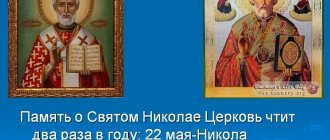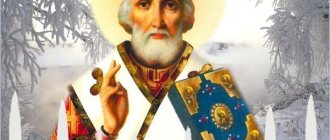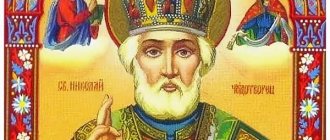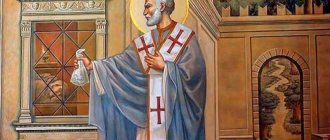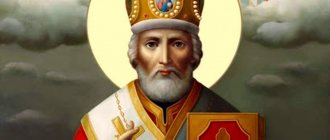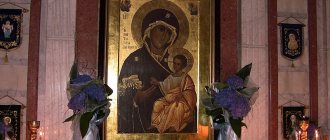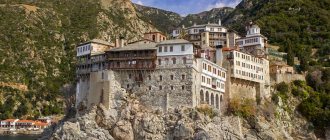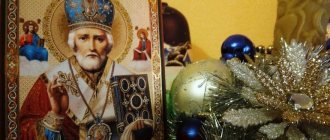Nikola Winter in the folk calendar coincides with the time of the winter solstice, when the days are shortest and the nights are darkest and longest
The folk calendar reminds us that, according to tradition, two days are celebrated in honor of St. Nicholas the Pleasant: the first - in winter, December 19 (this day is called the holiday of St. Nicholas the Winter) and in the spring - St. Nicholas of the Spring, May 22.
It is believed that it is during these difficult days that the saint visits the Russian land, walking around it all in one day and dispersing the spirits of darkness. Indeed, after the winter solstice, the day begins to gradually increase.
St. Nicholas Day comes shortly before the Nativity of Christ and Christmastide, so in Rus' preparations for the holidays began with St. Nicholas the Winter. Young people began to prepare scary masks and mummer costumes, and gatherings were also held with Lenten treats (this is the time of the Nativity Fast, but in honor of the holiday some concessions are allowed - on St. Nicholas Day, hot Lenten food with vegetable oil, fish and wine are allowed).
With St. Nicholas the Winter in Rus', the time of winter matchmaking began, as well as the sale of grain surpluses.
When is St. Nicholas the Wonderworker Memorial Day celebrated in 2022?
There are several days of memory of St. Nicholas the Wonderworker in the Orthodox church tradition. On August 11, believers remember the birth of the saint, and on December 19 (new style, old December 6) - his death.
There is also a memorable date for the transfer of the relics of the wonderworker from Myra Lycia to Bari on May 22. These three holidays also had popular names - respectively, Nikola Autumn, Nikola Winter and Nikola Veshny (Summer). In addition, Nicholas in Rus' was called the Ugodnik (the same as the Wonderworker).
What to give to a child
Desired gifts for the baby:
- Sweets discovered in a beautiful bag;
- Homemade gingerbread cookies with a Christmas theme;
- Pajamas to help your little one sleep well;
- Toy animal or real animal;
- Little things for various crafts that you will do with the kids.
- Christmas tree decorations;
- Small items for home decoration;
- Garlands, interesting cards;
Gifts can be wrapped in multiple wrappers, making unwrapping a fun game. Be sure to tell your child how to make a wish so that it comes true. For an adult, an icon of a saint would be a good gift, as well as useful little things for home decoration.
Who was Saint Nicholas and what does Santa Claus have to do with it?
As the life of the saint says, Nicholas was born in the 3rd century in the Greek colony of Lycia in Asia Minor into a Christian family. The boy attended church from childhood, and as he grew up, he decided to devote himself entirely to the faith, becoming a priest. He distributed the rich inheritance of his parents to the poor. Over time, Nicholas was ordained as an archbishop in the city of Myra (now the territory of Turkish Antalya) and became famous as a zealous fighter against paganism and various heresies, as well as as a miracle worker and defender of the slandered and innocently condemned. Among the miracles performed by the saint during his lifetime are the salvation of the world from a terrible famine, as well as the resurrection of a sailor during a storm.
Saint Nicholas (as high church hierarchs are called) lived to a ripe old age. Immediately after his death, his body began to flow myrrh, and believers flocked to them for relief from illnesses and sorrows. The saint’s relics were first kept in Myra, where he served as archbishop, and already in the 11th century they were transferred to the city of Bari, in Italy. Some of them are still there.
Well, how can we forget that Saint Nicholas is the well-known Santa Claus; the personality of the saint in people’s minds has merged with a folklore character. This transformation occurred due to the story of an old man with three daughters being saved from poverty. Having learned about the terrible lack of money of his parishioner, the archbishop decided to help him. He just did it secretly - at night he threw a bag of gold into the window of the house where the family lived. In the morning the money was found, but nothing was known about the name of the benefactor. The delighted father, with the dowry received in such a miraculous way, was able to celebrate the wedding of his eldest daughter. After some time, Nikolai repeated his secret gift - this is how the poor man’s middle daughter got married. Needless to say, the archbishop committed a good deed for the third time - and here the old man was finally able to watch for him and thank him.
Thus began the tradition of giving gifts in the name of the saint to children from poor families, which later spread to all children, and then to adults.
Winter holiday of St. Nicholas December 19
The saint is commemorated at special services several times a year; in addition, every Thursday of the week is considered his day of remembrance. But December 19 is a special day. The Church celebrates the birth of the saint into the Kingdom of Heaven - his repose to the Lord.
Iconography: Nicholas the Wonderworker (half-length)Dating: XIX century. Material: Wood, tempera, gilding. Dimensions of the icon: height 32.5 cm, width 27 cm Half-length image of the saint. His head is crowned. In his left hand he holds the Gospel, and his right hand is raised in a blessing gesture. To the right and left of his face in the clouds are half-figures of Christ and the Mother of God. © Omsk Regional Museum of Fine Arts named after M.A. Vrubel
Interesting fact
People call this holiday “Winter Nikola”, or “cold”, since its celebration occurs in the winter.
The joy of the holiday is that from this day on, having helped people so much, he can be the intercessor not of hundreds, or even thousands of his spiritual children, but become the spiritual support of a much larger number of believers, not being limited by the body, but by the spirit, embracing the whole world with love .
Brief biography of the saint
We know everything about Saint Nicholas - but at the same time almost nothing. Paradoxically, because they loved him very much.
"Riddles" of the saint
The medieval author, when creating the life of the saint of God, paid attention to the very spirit of the saint, and was of little interest in the specific events of his life - he was born, studied, was ordained. What is the point of talking about earthly things when life is an example for imitation of spiritual life, an opportunity for prayerful communication with a beloved saint?
Therefore, in the lives of antiquity one can find what seems to us confusion, but to the creator of the biography - a pious comparison with other saints, to whom the saint is similar in everything. Modern theologians see similar moments in the life of St. Nicholas.
Useful materials
Back in the 19th century. church historian archim. Antonin (Kapustin) found out that the names of the saint’s parents, Theophan and Nonna, actually refer to another father, St. Nikolai Pinarsky, who lived in the 6th century;
Stories about the childhood of the future bishop are also considered not very historically reliable, since this part of the life is rather a diagram, an image of an ideal child, which, according to the medieval writer, a saint should be.
Young Nicholas did not travel to the Holy Land to worship shrines: at that time the Temple of the Resurrection did not yet exist, the Cross of the Lord had not been found, moreover, all Christian shrines were destroyed as much as possible, at the site of the Crucifixion of the Lord there was a pagan temple, and even Jerusalem was somehow at that time it was called Elia Capitolina. The name of the city, like the city itself, began to be restored after 325, when Constantine the Great became emperor.
But the confessional feat of St. Nicholas during the persecution of Christians by Emperor Diocletian actually took place at the beginning of the 4th century. It is believed that when the persecution occurred, St. Nikolai was arrested, and he spent about 20 years in prison; modern studies of his relics have shown that the saint of God, apparently, was tortured more than once; from the dampness of the prison, he suffered from joint pain all his life. However, the lives say almost nothing about this long period of the saint’s life.
Some believe that there could not have been a bishop at the First Ecumenical Council - the city of Myra was too modest; however, according to the latest research, archim. Vladimir (Zorin) and historian A. Bugaevsky, St. Nicholas could well have been present among the participants of the Council.
And yet we know about the saint - not so much where and how he lived, but what he was like.
Young Bishop
The city of Mira no longer exists. But in the IV century. it was the capital of the Lycia region of Asia Minor, a very significant city. Historians say that the city even at one time had the right to issue its own coin. It was here that Nicholas, a native of Patar, became bishop around 300.
Some say that he was already a priest - he was ordained by his uncle, the Bishop of Patara. Others say that Nicholas was a layman. Historians believe both versions are possible: in the 4th century. the appointment of a layman as bishop was quite possible.
One way or another, Nikolai, young, but already respected, glorified by many for his virtues, did not want human glory, and, apparently, that’s why he ended up in the Worlds. After all, everyone knew him in his native Patara, but here there was an opportunity to remain unknown to anyone.
This, as life says, was already the second attempt to move away from worldly temptations: Nicholas was already leaving for a deserted monastery founded by his uncle. But the Divine voice, heard by the ascetic, commanded him to return to serving people. The election to this obedience took place after the death of the secular bishop John.
Several worthy bishops saw in a vision that the new Bishop of the World would be the person who would be the first to come to the church for the morning service. Nikolai loved worship, so he always came after dark. This is how the bishop met him, telling him the Divine will. From then on, until his death around 343, the life of the saint was connected with this city.
Good Shepherd
Nicholas the Wonderworker Iconography: Nicholas the Wonderworker, saint, Life cycle of St. Nicholas the Wonderworker Dates: XVIII century. Material: Wood, tempera Icon dimensions: height 126.5 cm, width 68 cm Temple icon. In the centerpiece with a wide golden frame, St. Nicholas the Wonderworker is depicted full-length and frontal. The face is lifelike, on the head is a golden miter with white trim, graying hair, mustache and beard, above the head is a golden halo with a white outline. Dressed in a scarlet sakkos, woven with gold floral patterns. The sleeves and hem are golden with imitation precious stones with crosses. Greenish-blue omophorion with crosses. The saint’s right hand is raised in a blessing gesture, and his left hand holds a staff. In the upper part of the middle, on a scarlet background in cloudy segments, there are half-figures of Christ with the Gospel and the Mother of God with an omophorion in the rays. In 14 stamps along the perimeter of the middle of the biography and deeds of St. Nicholas the Wonderworker: 1. Nativity of St. Nicholas 2. Baptism of St. Nicholas 3. Healing of a withered wife 4. Bringing into teaching 5. Ordination to deacon 6. Ordination to archbishop 7. Deliverance of three husbands from the sword 8 Appearance of St. Nicholas to Tsar Constantine 9. Rescue of Patriarch Athanasius from drowning 10. Deliverance of Peter of Arabia from prison 11. Miracle of the Three Maidens 12. Repose of St. Nicholas 13. Burial of St. Nicholas 14. Return of Agrikov’s son from Saracen captivity. Inv. No. SKM VH 130. © Kostroma State Historical, Architectural and Art Museum-Reserve
It should be said that in the first centuries of Christianity the principle of “one city - one bishop” was observed, that is, the dioceses were small. But the bishop knew well every Christian in the city, his needs and problems. Such was Saint Nicholas.
He not only knew the needs and sorrows of his flock, but he knew how to instruct without condemnation, to help without humiliating. The case of a noble but completely impoverished man is well known. Oppressed by need and his humiliated position, he decided to sell his three daughters to whoredom. Despair, painful pride, lack of hope in the Lord - all of this could expose a sinner. But Nikolai acted differently.
At night, unnoticed, he threw a bundle of gold through the man’s window. Just helped. And he did it secretly, knowing that pride would not allow the parishioner to accept help. When the story with the money was repeated up to three times, the man who had fallen into despair came to his senses. But even then the bishop, after whom he ran down the street with tears of gratitude, did not say a word of even the slightest accusation.
Travel Assistant
Historical, not very reliable news about the journey of St. Nicholas to the Holy Land, most likely preserved very real data about his assistance to sailors during a storm. They say that while traveling on a ship, he foresaw a storm in advance. And when, during a storm, a young sailor fell from the mast and fell to his death - St. Nicholas resurrected him with his fervent prayer.
Zeal for God
The life of the saint mentions his participation in the First Ecumenical Council, where the question of the teachings of the Alexandrian priest Arius, who denied the Divinity of Jesus Christ, was decided. The educated, energetic Mir bishop is believed to have been one of the most active polemicists against Arianism. And at some point he hit the heretic on the cheek, unable to bear his blasphemies.
Tradition tells that the fathers of the Council did not approve of such an act, considering it jealousy beyond reason. Therefore, they deposed the Bishop of Mir from his dignity. But that same night, several worthy participants in the Council saw the same vision: Christ and the Mother of God placing the bishop’s omophorion on Nicholas’s shoulders. After this, the decision to defrock him was canceled, considering that God’s judgment was fairer than man’s.
Champion of Justice
The saint was rarely seen angry. Almost the only such case was preserved by the lives, as well as the pages of an ancient manuscript known as the “Act of the Stratelates.” The saint met these military leaders - the stratilates - while in the city of Andriake. Here on the pier there was a quarrel between soldiers and local residents, but the bishop managed to establish peace. And then he called the three stratilates to him.
But the conversation had barely begun when alarmed townspeople from Mir burst into the house: the local mayor was about to execute three innocent residents. The saint, already elderly, realized that he would not have time. Then the soldiers offered their help to him: in the name of the emperor, they delayed the execution until Nicholas reached the city. The moment when he angrily holds the executioner’s sword is depicted in many icons, even in paintings.
The story of how Nikolai and the three warriors met did not end there. Returning from the campaign, they were slandered, after which they themselves found themselves under arrest. Emperor Constantine had already signed their death warrant. Then the stratilates began to boldly pray to the saint, who was not even nearby. That same night he appeared to the king in a menacing vision:
“Konstantin, get up quickly and free the three commanders languishing in prison. They were slandered by the prefect, who received a bribe, and unjustly sentenced to death by you. If you disobey me and do not let them go, I will start a war against you...”
The frightened king could hardly believe that this was the good saint about whom he had heard so much. The next day the governors were released. Once again they went to Myra to thank the saint, to present the precious Gospel and a chalice to the temple. This was their last meeting in earthly life. After a short time, St. Nikolai died.
What do they pray to Saint Nicholas for?
Photo: Serguei Bulavsky, globallookpress.com
St. Nicholas is considered the patron saint of sailors, travelers and merchants. Therefore, he was asked for successful navigation and protection of ships from storms and storms. In addition, they pray to him for a miraculous resolution of a difficult matter or particularly incredible luck. It also helps to restore justice to those who were convicted based on false libel, and also protects children, especially orphans, from troubles and misfortunes.
Modern miracles of St. Nicholas
These stories are from the editorial mail of the Pravoslavie.Ru portal. They asked their readers to tell about cases of miraculous help from St. Nicholas. So many stories came (and are still coming) that they simply could not publish them all. We sincerely thank those who found the strength and time to share their innermost experience.
Olga Bryantseva. “Before traveling, you should definitely pray to St. Nicholas”
I want to tell you an amazing story that happened to my family. Three years ago we traveled around Europe by car: my husband was driving, I was next to him as a navigator and my son was in the back seat. We moved from country to country: we traveled during the day and stayed in hotels at night.
And now we are approaching the Italian city of Verona, where we planned to spend the night - the hotel room was booked in advance. The time was already late, about 11 pm. We entered the city and apparently took a wrong turn somewhere. It’s dark - even if you gouge out an eye, you won’t see a soul. There is no one to ask, there are no signs, we can’t find our way on the map. I tell my husband: go straight, or something. She quietly, silently prayed to Saint Nicholas: “Saint Nicholas, help us find the way!” We were driving straight ahead, and suddenly we saw that it looked like some kind of hotel, but by name it wasn’t ours. I tell my husband: go in, find out if they have free rooms, otherwise it’s already late, or at least ask what area of the city we are in. And he, apart from a scanty knowledge of French, does not know any other languages, and the likelihood that he will understand anything at all is minimal, especially since Italians, as a rule, do not know other languages besides their native one. Literally three minutes passed: we looked - our dad was running. He says: can you imagine, the receptionist at this hotel surprisingly knows French! And he said that our hotel is around the corner!
Just like that, Saint Nicholas heard the prayers of us sinners. And so he helped us all the way, led us like a compass, and there were no problems on our long journey. Before traveling, you should definitely pray to St. Nicholas and order a prayer service. He will definitely help. Saint Nicholas, pray to God for us!
Igor Yakubovich. “For two and a half years I lived with the dream of returning”
It was many years ago, on Estonian soil, in the city of Rakvere. I had a favorite job. But one day, after working for more than one year, I lost her through my own fault.
For two and a half years I lived with the dream of returning, I knocked all the doorsteps of this enterprise, but my former master flatly refused to take me back.
Once, on the advice of my ardently believing Orthodox aunt Nina (God bless her), I went to our Orthodox Church of the Nativity of the Blessed Virgin Mary and prayed earnestly to St. Nicholas the Wonderworker in front of his icon and asked for only one thing: to be loved again at my work...
A week later, my former master was fired for theft, and a week later I was called back to my favorite job. And this is just one of the many miraculous help of St. Nicholas the Wonderworker to me, a sinner. God bless!
Galina K. With the help of St. Nicholas, she got rid of smoking
For a long time I tried to quit smoking, periodically I succeeded, but not for long. Almost forty years of experience! I was afraid to ask God for help: I thought it was a terrible sin to handle something like this! But she continued to read Orthodox literature, delve into the words of prayers, and tried to come to church services more often. Before Great Lent, I lingered in the church near the icon of St. Nicholas, and for some reason I had an impulse to ask for help in getting rid of a bad habit. I don’t remember whether I read the holy prayer, but I remember that tears flowed frantically and the words came from the depths of my heart...
Then she walked away from the icon, looked from a distance and was surprised - the stern face of St. Nicholas seemed to soften, and his eyes looked tenderly and sadly straight into my eyes!
That same evening the temperature rose sharply. I’m omitting the details of the illness - the doctor diagnosed ARVI, but for a couple of nights I thought I was dying and humbly prayed as best I could... I’ve never been so seriously ill! Two weeks later, when I could already breathe freely, the thought of cigarettes caused disgust and, strangely, the feeling that I had never smoked at all. I am happy that I entered Great Lent, having, with the help of St. Nicholas the Wonderworker, gotten rid of one destructive passion - smoking and, of course, brought him prayers of thanks. Thank God for everything! The icon is located in the Church of Demetrius of Thessalonica.
Ekaterina B. “Thank you to Nikolai Ugodnik for a wonderful son!”
We had an icon of St. Nicholas the Wonderworker hanging in our kitchen, and in difficult moments I would kneel down and talk to him.
There was a very difficult period in my life. I was pregnant, the young man did not want either a child or marriage.
My mother was also against it, because I was very young and I needed to study. Every day I delayed the moment of going to the hospital and asked Nikolai Ugodnik to help me, I even wrote notes and put them behind the icon. I was so confident that everything would be fine! But I had no idea how. A boy was born. She named him Daniel. It was hard for us with him, everyone turned away from us. The young man began to live with another woman, his mother left the apartment and only passed milk and bread through her brother. The first four months after the birth of my son we spent with him in the hospital; he was very weak.
The first year I practically did not sleep every night (a nervous pregnancy made itself felt). Two years later, the child’s father returned, I accepted him, and we got married, but he did not behave very well. I didn’t work anywhere, I drank, I went out, and I forgave everything - for the sake of my son!
Now my son is 14 years old, he is studying, with God’s help, at a prestigious school, I received a higher education and a successful job. My husband, the child’s father, still doesn’t understand how the baby and I were able to get out of this situation! My son and I are best friends, we relax together, talk about everything! He supports me, I support him. My son began to observe fasts, but I had not yet observed them!
And I felt so ashamed when a child asks me to cook lean food for him! Now I started fasting too - he taught me!
Thanks to Nikolai Ugodnik for a wonderful son!!!
How they were revered in Rus': traditions of celebrating the saint’s day of memory
In honor of St. Nicholas the Wonderworker, Princess Olga built the first Christian church on Kyiv soil. Since then, many churches dedicated to him have been built in Rus' and monasteries have been founded - more than to any other saint in general. Even one of the towers of the Moscow Kremlin is named Nikolskaya.
In addition, Nikolai Ugodnik is truly a national saint. They revered him as the “elder” among the saints, placed him very highly, and it was from him that they most often asked for intercession and help. For example, the proverbs say a lot: “There is no champion for us against Nikola”; “Ask Nikola, and he will tell Spas.” And even today, 95% of all pilgrims to Bari (70 thousand a year) come from Russia. And when the relics of the saint were brought to Moscow in 2022, people stood in line for 10 hours to venerate them.
St. Nicholas of the Summer May 22 was often called Grass Day. It was believed that by this time it was necessary to pay off all existing debts, make peace with those with whom you were in a quarrel, and be sure to help those in need. And on this day, matchmakers visited houses with unmarried young girls - matchmaking with Nikola promised to be successful.
Photo: Serguei Bulavsky, globallookpress.com
In the spring, Nikolai was approached with requests to protect the livestock and the future harvest. They tried not to eat meat on this day; religious processions were held in some areas to protect crops from hail and drought. The peasants believed that on the eve of the holiday the saint descended into the world and walked around the fields.
Nikola Winter December 19 was also a revered day. According to legend, on this day the saint, as in the spring, walked around the earth from end to end, driving away evil spirits from the human world. In some regions, in honor of his memory, fraternities (“Nikolshchiny”) were organized: after the service, a large meal was collected for the entire village. To do this, as a rule, they slaughtered a bull bought with common money or raised by all the villagers.
On the day of St. Nicholas, it was also customary to conclude various business transactions and agreements. The prices established at that time were considered inviolable, because “Nikolsky’s bargaining is a decree for everything.” Also on Nikola they sold excess bread.
The Nativity of St. Nicholas on August 11 was celebrated only in the Russian tradition of Orthodoxy; this holiday was not included in the calendars of other Orthodox churches. During the reign of Catherine II, the celebration of this day was abolished, but recently the custom of honoring the memory of the saint is gradually returning in August.
How the holiday is celebrated
The main tradition on St. Nicholas Day is receiving gifts. Children especially look forward to this day, because in the morning you can find sweets or other interesting gifts under your pillow. But in order for Nikolai to leave a surprise, the child had to behave well, honor and obey his elders throughout the previous year. As for the disobedient hooligans, only rods awaited them.
Under Kievan Rus, St. Nicholas Day was an Orthodox holiday for adults as well. It was customary to set the festive table and gather around it with relatives. Having cheerfully celebrated the celebration at the table, people went for a walk on the street, to ride around the villages on a sled with the best horses. In some areas they cooked kutia and uzvar, they believed that this would bring a good harvest. They tried to bless livestock with water in order to protect themselves from adversity.
The holiday was especially revered by girls. If she was soon to get married, then she had to clean the house for the holiday. Carefully fold all things, prepare wedding decorations and the outfit in which to meet the matchmakers. Also on the festive night, girls engaged in fortune-telling, most often they were associated with their betrothed, in addition, rituals were performed. It was generally accepted that the image that a girl saw at night would become her betrothed in the future.
Over the centuries, the traditions of the holiday have changed many times. Changes depend on the specific location and historical period.
But some rules of celebration have not changed:
- on this New Year's Eve, it was customary to attend a solemn service in the Temple;
- the family needs to gather around a set table;
- guests are treated to beer and cooked dishes;
- At night, during the holiday, children are given sweets or a small gift under their pillow, in their shoes or a festive sock;
- gifts are given not only to children, but also to loved ones.
